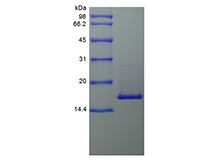Interleukin-36 is a pro-inflammatory cytokine which plays an important role in the pathophysiology of several diseases. IL-36α, IL-36β, and IL-36γ (formerly IL-1F6, IL-1F8, and IL-1F9) are IL-1 family members that signal through the IL-1 receptor family members IL-1Rrp2 (IL-1RL2) and IL-1RAcP. IL-36 beta is reported to be expressed at higher levels in psoriatic plaques than in symptomless psoriatic skin or healthy control skin and it can stimulate production of interleukin-6 and interleukin-8 in synovial fibrobasts, articular chondrocytes and mature adipocytes. IL-36 beta has two isoforms. IL-36β2 contains one potential N-linked glycosylation site in its C-terminus, while IL -36β isoform 1 lacks potential N-linked glycosylation sites and four of the conserved β-strands. Within the IL-1 family, IL-36β/IL-1F8 shares 30 %, 32 %, 37 %, 46 %, 34 %, 45 % and 28 % a.a. sequence identity with IL-1 ra, IL-1β, IL-36Ra/IL-1F5, IL-36α/IL-1F6, IL-37/IL-1F7, IL-36γ/IL-1F9 and IL-1F10, respectively.

